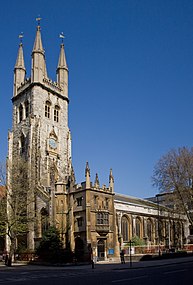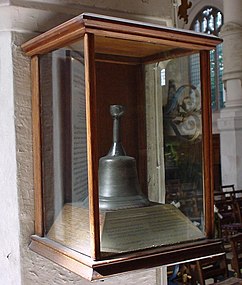St Sepulchre-without-Newgate
| Saint Sepulchre-without-Newgate | |
|---|---|
| Holy Sepulchre, London | |
| Church of the Holy Sepulchre, London Church of saint Edmund the (King and) Martyr and of the Holy Sepulchre (obsolete) Church of saint/Saint Sepulchre, Holborn/Middlesex (dated) | |
London | |
| Deanery | City of London (sole deanery in archdeanery) |
| Parish | St. Sepulchre with Christchurch, Greyfriars and St. Leonard, Foster Lane (as sole church of) |
| Clergy | |
| Priest in charge | Rev. Nick Mottershead |
Holy Sepulchre London, formerly and in some official uses Saint Sepulchre-without-Newgate, is the largest
It has London's musicians' chapel in which a book of remembrance sits and an October/November requiem takes place – unusual for a church associated with Low Church Evangelicalism. The church has two local army regiment memorials.
The vicar is appointed by St John's College, Oxford, which has held the church's patronage since 1622.
The church is within the Newgate Street
History
The original (
The church is today the largest parish church in the city.

During
Bells
The bells are referred to in the nursery rhyme Oranges and Lemons as the "bells of Old Bailey".[13]
In 1605, London merchant tailor John Dowe paid the parish £50 (equivalent to £14,000 in 2023) to buy a handbell and to mark the execution of prisoners at the nearby gallows at Newgate.[14] This execution bell is displayed in a glass case in the nave. Between the 17th and 19th centuries, the clerk was responsible for ringing it outside the condemned man's cell in Newgate Prison the night before his execution, and announcing the following "wholesome advice":[14][1]
All you that in the condemned hold do lie,
Prepare you, for to-morrow you shall die;
Watch all, and pray, the hour is drawing near
That you before the Almighty must appear;
Examine well yourselves, in time repent,
That you may not to eternal flames be sent.
And when St Sepulchre's bell to-morrow tolls,
The Lord above have mercy on your souls.
Past twelve o'clock!
Given proximity to Newgate Prison and the Old Bailey, built on the site of the prison, certain of the bells in its tower, aside from marking time, celebrating weddings and communion, were rung to announce executions. In the first years of the court this was as the condemned felon was led to Tyburn.[1][15]
-
The bell tower
-
The Execution Bell
-
Exterior
Musicians' Chapel
By the north aisle is the Musicians' Chapel. As St Stephen's chapel it hosted votive masses to the 12th-century monastic saint Stephen Harding prior to the English Reformation and during the reign of Mary I of England.[16]
The ashes of conductor Sir
It was rededicated to musicians by Dr. W.R. Matthews, Dean of St Paul's, on 2 January 1955 in the presence of many distinguished musicians including an orchestra conducted by Sir Malcolm Sargent and the BBC Singers.[16] Its four windows commemorate Sir Henry Wood, John Ireland, Dame Nellie Melba and Walter Carroll[16]
The chapel's appearance and the Musicians' Book of Remembrance are maintained by the Friends of the Musicians' Chapel. A Service of Thanksgiving for all those in the book is held at the church each year as well as a requiem close to All Souls' Day. Many concerts and memorial events for musicians have been held in the church. In 2017 the vicar ceased parish funds financing the requiem and allowing of most free rehearsing time. A protest was held and many prominent musicians including John Rutter sought continued benevolence from the wider congregation and church patron. Attempts to mediate failed.
Army memorials
The south aisle of the church holds the regimental chapel of
Protection and recognition of architecture
The church has been designated a Grade I listed building (the highest grade) since 1950.[11]
Notable people associated with the church
- Thomas Culpeper, Tudor courtier, buried here
- Thomas Gouge, minister ejected in 1662
- Samuel Gurney, MP, erected the first drinking fountain for the Metropolitan Drinking Fountain and Cattle Trough Association on the railings of the church. It was restored to the original location in 1913 and remains there.
- Rev Dr Peter Mullen, commentator, author and former rector, sometime chaplain to the London Stock Exchange
- John Rogers, minister, Bible translator, and the first English Protestant martyr under Mary I of England; he was burnt at the stake
- Sir Anthony St Leger, Tudor judge, and his first wife Eleanor Markham, buried here
- Sir John Smith, governor of Virginia and associate of Pocahontas, buried 1631 in the south aisle. Smith is also commemorated by a window designed by Francis Skeat and installed in 1968.[18]
- Austin Osman Spare, artist, attended the church school, now a physiotherapy centre, behind the church in Snow Hill Court
- Roger Williams (1603–1683), founder of Rhode Island, USA
- Sir Henry Wood, founding conductor at the Proms
- Charles Wriothesley, long-serving officer of arms at the College of Arms, buried 1562 in the middle aisle
Organ

The north aisle is dominated by a splendid organ built by Renatus Harris in 1670;[19] the organ case is its sole mention in the architectural listing, adding a date, 1677.[11]
The swell was added by John Byfield in c. 1730. The organ was enlarged in 1817 by James Hancock and by John Gray in 1828 and 1835, and
The choir has now composed of eight professional singers.
Organists
- Francis Forcer 1676–1704
- Thomas Deane 1705–1712
- Benjamin Short 1712–1760
- William Selby and Samuel Jarvis 1760–1773
- Samuel Jarvis 1773–1784
- George Cooper 1784–1799
- George Cooper 1799–1843 (son of above)
- George Cooper 1843–1876 (son of above)
- James Loaring
- Edwin Matthew Lott
- Edgar Pettman
- Frank B. Fowle c. 1921
- Peter Asprey (Director of Music; present)
- Joshua Ryan (Organist elect; from May 2022)
See also
- List of churches and cathedrals of London
References
- ^ a b c Piper, David; Jervis, Fionnuala. The Companion Guide to London. p. 350.
- ^ a b c "Newgate: Conservation Area Character Summary" (PDF). Corporation of London. 1999.
- ^ "Newgate Street Conservation Area [No. 6]". City of London Corporation.
- ^ "The City of London Churches: monuments of another age" Quantrill, E; Quantrill, M p. 24: London; Quartet; 1975
- ^ a b "The City Churches" Tabor, M. p. 127: London; The Swarthmore Press Ltd; 1917
- ISBN 0140094180.
- ^ "The Survey of Building Sites in London after the Great Fire of 1666" Mills, P/ Oliver, J Vol I p. 124: Guildhall Library MS. 84 reproduced in facsimile, London, London Topographical Society, 1946
- Batsford.
- ^ Dictionary of British Sculptors 1660–1851 by Rupert Gunnis
- ^ "1628 – Joshua Marshall". Retrieved 10 October 2022.
- ^ a b c d e Historic England. "Details from listed building database (1064640)". National Heritage List for England. Retrieved 23 January 2009.
- ISBN 0300096550
- ^ "Our Community — Bells". stsepulchres.org.
- ^ a b St. Sepulchre's and its neighbourhood. Old and New London, Volume 2. Cassell, Petter & Galpin (courtesy of British History Online). 1878. pp. 447–491.
- ^ "London's secret sights: 14 odd attractions you never knew were there". The Daily Telegraph.
- ^ ISBN 978-1405049245
- ISBN 0955394503
- ^ "The John Smith Window". St. Sepulchre-without-Newgate. Retrieved 22 December 2010.
- ^ Pearce,C.W. "Notes on Old City Churches: their organs, organists and musical associations" London, Winthrop Rogers Ltd 1909
- ^ "The National Pipe Organ Register – NPOR".
- ^ "Fundraising for Organ Restoration and Piano Replacement". Holy Sepulchre London. Retrieved 16 April 2022.
External links
- St Sepulchre-without-Newgate church website
- St Sepulchre-without-Newgate at Find a Grave



